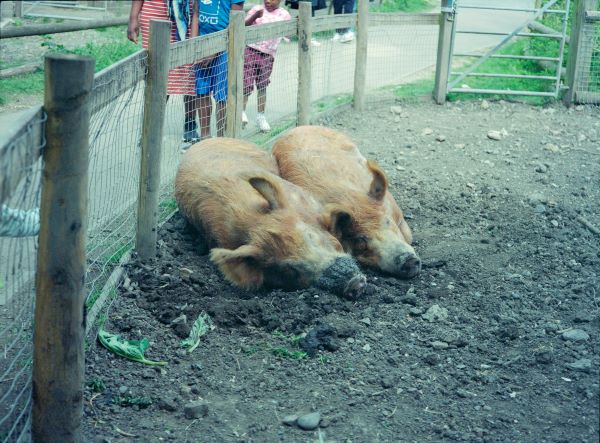Keeping African livestock isn’t just about money but also about looking out for the community. When wild animals attack, it messes with farmers’ income, throws local economies off balance and messes up the food security of entire communities — like a domino effect on people’s lives.
1. Understanding the Local Wildlife
Africa has one-third of the world’s livestock, with chickens being the most common livestock, with about 2.4 billion in 2022. Goats and sheep followed with around 506 million and 419 million.
The country also had approximately 382 million cattle in the same year. When it comes to protecting African livestock, watch out for these troublemakers:
- Lions: Savanna rulers love prowling in open grassland, posing a threat to livestock.
- Hyenas: Clever scavengers that adapt to different habitats, from grasslands to woodlands.
- Leopards: Sneaky climbers that can adapt to various environments, making them a threat to livestock in different settings.
- Wild dogs: Persistent predators thriving in open woodlands. Knowing where they hang out helps farmers protect their livestock better.
Understanding their behavior and habitats is the key to farmers taking the proper steps to keep their animals safe.
2. Scare Tactics and Repellents
Use methods to discourage wild animals from getting near livestock. Scarecrows are human-like figures that scare off birds and small animals.
To scare animals away, you can use shiny materials like tape or CDs to create flashes. Spraying predator urine around scares animals off. Scents like peppermint or citrus can repel animals when sprayed around.
3. Early Warning Systems and Monitoring
Early warning systems help farmers detect wildlife near their livestock quickly. These systems provide alerts and data on wildlife activity using motion sensors and camera traps. Farmers can find these systems in agricultural stores or online and seek advice from wildlife agencies to tailor them to local threats.
4. Fencing and Enclosure
Proper fencing and enclosures are crucial to keep wildlife away and protect both livestock and the environment. They prevent conflicts and ensure the safety of animals.
Check and fix the fence regularly to prevent vulnerabilities. Adapt it to the landscape, considering slopes and water bodies.
Strong fencing prevents predators like foxes and coyotes from digging under it and makes it hard for them to climb. You can also cover the chickens’ area with a mesh trap, securing it with cable ties.
Combine fencing with noise or visual cues to discourage wildlife. Additionally, bird netting can be stretched over the fencing to deter birds of prey.
Here are the types of fencing for different livestock and wildlife:
- Electric fences: Deters larger wildlife without harm, like elephants or predators.
- Woven wire fences: Sturdy for smaller livestock like sheep or goats.
- Barbed wire fences: Cost-efficient and effective for cattle.
- Chain link fences: Versatile, suitable for various livestock, including poultry.
5. Secure Feed Storage and Waste Management
Use sealed containers to keep feed away from pets. Keep them off the ground to make it harder for wildlife to reach. Use lockable storage to deter access.
Check for damage or pests to prevent waste. Give animals only what they need to avoid leftovers. Keep areas tidy to reduce attraction to pests and wildlife.
6. Lighting and Noise
Bright lights and loud noises can scare away wild animals from livestock areas by disrupting their senses and signaling human presence. So, if you have roosters and hens, don’t worry about them. They’re equipped with particular adaptations up to 130 decibels to protect their eardrums from damage when a rooster crows loudly.
Strobes or LEDs mimic movement, confusing nocturnal predators. Loud alarms startle animals, prompting them to flee. Motion-activated devices trigger lights or noise when detecting movement, scaring off wildlife.
7. Herding Practices
Good herding practices protect livestock from wildlife attacks and promote safety and coexistence. Employ skilled herders to guide and protect livestock from staying in risky areas. Rotate grazing areas to spread our pressure and reduce the risk of attracting predators.
8. Guardian Animals
Integrating guardian animals into herds or flocks provides an extra defense against potential threats They are natural protectors that help keep livestock safe from predators.
Start guardian animals young so they bond with the livestock and learn their protective role. Encourage positive interactions between guardian animals and livestock to build trust.
Monitor their initial interactions closely to prevent conflicts. Reinforce protective behaviors through regular training. Keep an eye on their performance and address any issues promptly.
Some practical guardian animals are dogs, donkeys and llamas. Dogs are known for their loyal and instinctive behavior. In fact, in New Zealand, approximately 200,000 herding dogs are actively working.
Donkeys dislike canines and are formidable adversaries for predators. Llamas are natural protectors and can ward off threats from smaller predators like coyotes or foxes.
9. Wildlife Conservation Measures
Places like national parks give wildlife safe habitats to thrive. Wildlife corridors connect these areas, allowing animals to move safely between habitats.
Conservation efforts can bring economic opportunities like tourism and sustainable resource management. Involving locals makes conservation everyone’s job.
10. Community Collaboration and Knowledge Sharing
Sharing knowledge benefits everyone, helping communities make better decisions and solve problems creatively. Successful initiatives like training guardian dogs and wildlife conservation areas show the power of community efforts. Online platforms and workshops also provide farmers, researchers and conservationists opportunities to exchange ideas and develop effective strategies.
Protecting Livestock from Wildlife
Keeping livestock safe from wild animals demands proactive steps and thoughtful strategies. With commitment and teamwork, people can create a balanced environment where both livestock and wildlife can thrive.

Jane is an agriculture and environmental journalist and the founder and editor-in-chief of Environment.co, where she covers sustainability and eco-friendly living.









